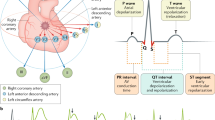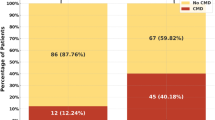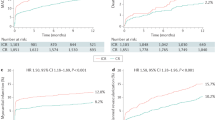Abstract
Acute ST-segment elevation myocardial infarction is estimated to occur in more than 500,000 people in the US every year. With the introduction of reperfusion therapy by fibrinolysis or primary angioplasty, mortality has significantly fallen. Although fibrinolysis is more readily available than primary angioplasty, the latter is more effective and results in better short-term and long-term outcomes if performed in a timely manner by an experienced operator and hospital team. The ischemic time, door-to-balloon time and clinical risk are important determinants of favorable outcome. Primary angioplasty is the preferred reperfusion strategy when symptom onset is longer than 3 h, in high-risk patients, such as those with cardiogenic shock, congestive heart failure or elderly age, and those with contraindications for fibrinolysis. Primary angioplasty is the preferred strategy in interventional facilities, with a goal door-to-balloon time of less than 90 min. For patients who present to noninterventional facilities, transfer to a hospital capable of primary angioplasty is safe and effective if the additional treatment delay is less than 90 min. Facilitated percutaneous coronary intervention has been shown in several small trials to offer early vessel patency and improve outcomes compared with fibrinolysis alone, but has not been shown to reduce mortality. Larger trials are ongoing to evaluate the benefit of this approach. The establishment of an effective and efficient system for the rapid transport of patients to centers capable and experienced in primary angioplasty is severely needed to provide optimum treatment and outcomes to patients with ST-segment elevation acute myocardial infarction.
This is a preview of subscription content, access via your institution
Access options
Subscribe to this journal
Receive 12 print issues and online access
$209.00 per year
only $17.42 per issue
Buy this article
- Purchase on Springer Link
- Instant access to full article PDF
Prices may be subject to local taxes which are calculated during checkout





Similar content being viewed by others
References
American Heart Association (2004) Heart Disease and Stroke Statistics—2004 Update. [http://www.americanheart.org/downloadable/heart/ 1079736729696HDSStats2004UpdateREV3-19-04.pdf] (accessed 4 October 2004)
Steg PG et al. and GRACE Investigators (2002) Baseline characteristics, management practices, and in-hospital outcomes of patients hospitalized with acute coronary syndrome in the Global Registry of Acute Coronary Events (GRACE). Am J Cardiol 90: 358–363
Antman EM et al. (2004) ACC/AHA guidelines for the management of patients with ST-segment elevation myocardial infarction: executive summary: a report of the ACC/AHA Task Force on Practice Guidelines (Committee to Revise the 1999 Guidelines in the Management of Patients with Acute Myocardial Infarction). Circulation 110: e82–292
Collins R et al. (1997) Aspirin, Heparin and Fibrinolytic Therapy in Suspected Acute Myocardial Infarction. N Engl J Med 336: 847–860
Vertsraete M (2000) Third-generation thrombolytic drugs. Am J Med 109: 52–58
Gibson CM et al. for the TIMI Study Group (2002) Relationship of the TIMI myocardial perfusion grades, flow grades, frame count, and percutaneous coronary intervention to long-term outcomes after thrombolytic administration in acute myocardial infarction. Circulation 105: 1909–1913
Morrison LJ et al. (2000) Mortality and prehospital thrombolysis for acute myocardial infarction: A meta-analysis. JAMA 283: 2686–2692
Morrow DA et al. (2002) Evaluation of the time saved by prehospital initiation of reteplase for ST-elevation myocardial infarction: results of the Early Retaplase-Thrombolysis in Myocardial Infarction (ER-TIMI) 19 trial. J Am Coll Cardiol 40: 71–77
Bonnefoy E et al. Comparison of Angioplasty and Prehospital Thrombolysis in Acute Myocardial Infarction study group (2002) Primary Angioplasty versus prehospital fibrinolysis in acute myocardial infarction: a randomized study. Lancet 360: 825–829
Theroux P and Welsh RC (2003) Meta-analysis of randomized trials comparing enoxaparin versus unfractionated heparin as adjunctive therapy to fibrinolysis in ST-elevation acute myocardial infarction. Am J Cardiol 19: 860–864
Wallentin L et al. (2003) Efficacy and safety of tenecteplase in combination with the low-molecular-weight heparin enoxaparin or unfractionated heparin in the prehospital setting: the Assessment of the Safety and Efficacy of a New Thrombolytic Regimen (ASSENT)-3 PLUS randomized trial in acute myocardial infarction. Circulation 108: 135–142
Savonitto S et al. (2003) Risk of intracranial hemorrhage with combined fibrinolytic and glycoprotein IIb/IIIa inhibitor therapy in acute myocardial infarction. Dichotomous response as a function of age in the GUSTO V trial. Eur Heart J 24: 1807–1814
Keeley EC et al. (2003) Primary angioplasty versus intravenous thrombolytic therapy for acute myocardial infarction: a quantitative review of 23 randomized trials. Lancet 361: 13–20
Grzybowski M et al. (2003) Mortality benefit of immediate revascularization of acute ST-segment elevation myocardial infarction in patients with contraindications to thrombolytic therapy: a propensity analysis. JAMA 290: 1891–1898
Zijlstra F et al. (2002) Clinical characteristics and outcome of patients with early (<2 h), intermediate (2–4 h) and late (>4 h) presentation treated by primary angioplasty or thrombolytic therapy for acute myocardial infarction. Eur Heart J 23: 550–557
Widimsky P et al. on behalf of the PRAGUE Study Group Investigators (2003) Long distance transport for primary angioplasty vs immediate thrombolysis in acute myocardial infarction. Final results of the randomized national multicentre trial—PRAGUE-2. Eur Heart J 24: 94–104
Eisenberg MJ and Jamal S (2003) Glycoprotien IIb/IIa inhibition in the setting of acute ST-segment elevation myocardial infarction. J Am Coll Cardiol 42: 1–6
Antoniucci D et al. (2004) Abciximab-supported infarct artery stent implantation for acute myocardial infarction and long-term survival. Circulation 109: 1704–1706
Kent D et al. (2002) Is primary angioplasty for some as good as primary angioplasty for all? J Gen Intern Med 17: 887–894
Stone GW et al. (2002) Comparison of angioplasty with stenting, with or without abciximab, in acute myocardial infarction. N Engl J Med 346: 957–966
Antoniucci D et al. (2002) Relation of time to treatment and mortality in patients with acute myocardial infarction undergoing primary coronary angioplasty. Am J Cardiol 89: 1248–1252
Brodie BR et al. (2003) Importance of time-to-reperfusion in patients with acute myocardial infarction without cardiogenic shock treated with primary percutaneous coronary intervention. Am Heart J 145: 708–715
De Luca G et al. (2004) Time delay to treatment and mortality in primary angioplasty for acute myocardial infarction: every minute of delay counts. Circulation 109: 1223–1225
De Luca G et al. (2004) Time-to-treatment significantly affects the extent of ST-segment resolution and myocardial blush in patients with acute myocardial infarction treated by primary angioplasty. Eur Heart J 12: 1009–1013
Cannon CP et al. (2000) Relationship of symptom-onset-to-balloon time and door-to-balloon time with mortality in patients undergoing angioplasty for acute myocardial infarction. JAMA 283: 2941–2947
Angeja BG et al. and Participants in the National Registry of Myocardial Infarction 2-3 (2002) Predictors of door-to-balloon delay in primary angioplasty. Am J Cardiol 89: 1156–11561
Nallamothu B and Bates E (2003) Percutaneous coronary Intervention versus fibrinolytic therapy in acute myocardial infarction: is timing (almost) everything? Am J Cardiol 92: 824–826
Magid DJ et al. and National Registry of Myocardial Infarction 2 and 3 Investigators (2000) Relation between hospital primary angioplasty volume and mortality for patients with acute MI treated with primary angioplasty versus thrombolytic therapy. JAMA 284: 3131–3138
Dalby M et al. (2003) Transfer for primary angioplasty versus immediate thrombolysis in acute myocardial infarction. Circulation 108: 1809–1814
Andersen HR et al. and DANAMI-2 Investigators (2003) A comparison of coronary angioplasty with fibrinolytic therapy in acute myocardial infartion. N Engl J Med 349: 733–742
Muller DW and Topol EJ (1992) Thrombolytic therapy: adjuvant mechanical intervention for acute myocardial infarction. Am J Cardiol 69: 60A–70A
The TIMI study group (1989) Comparison of invasive and conservative strategies after treatment with intravenous tissue plasminogen activator in acute myocardial infarction. Results of the thrombolysis in myocardial infarction (TIMI) phase II trial. N Engl J Med 320: 618–627
Ross AM et al. and for the PACT investigators (1999) A randomized trial comparing primary angioplasty with a strategy of short-acting thrombolysis and immediate planned rescue angioplasty in acute myocardial infarction: the PACT trial. J Am Coll Cardiol 34: 1954–1962
Widimsky P et al. (2000) Multicentre randomized trial comparing transport to primary angioplasty vs immediate thrombolyisis vs combined strategy for patients with acute myocardial infarction presenting to a community hospital without a catheterization laboratory: the PRAGUE Study. Eur Heart J 21: 823–831
Scheller B et al. and SIAM III study group (2003) Beneficial effects of immediate stenting after thrombolysis in acute myocardial infarction. J Am Coll Cardiol 42: 634–641
LeMay MR et al. (online 7 March 2004) Combined angioplasty and pharmacological intervention vs. thrombolysis alone in acute infarction (CAPITAL AMI) [http://www.acc04online.org/daily/news/newssummary.asp?sid=1&stid=4&newsld=2004-03-07] (accessed 5 October 2004)
Fernandez-Aviles F et al. (2004) Primary angioplasty versus facilitated intervention (Tenectaplace plus stenting) in patients with ST elevation acute myocardial infarction: Final results of the GRACIA-2 trial [abstract]. J Am Coll Cardiol 43: 289A
Kastrati A et al. (2004) Early administration of retaplase plus abciximab versus abciximab alone in patients with acute myocardial infarction referred for percutaneous coronary intervention. JAMA 291: 947–954
Ellis S et al. (2004) Facilitated percutaneous coronary intervention versus primary percutaneous coronary intervention: design and rationale of the Facilitated Intervention with Enhanced Reperfusion Speed to Stop Events (FINESSE) trial. Am Heart J 147: 1–8
Boehringer Ingelheim (online 11 November 2003) Boehringer Ingelheim and Genentech announce clinical trial evaluating metalyse (TNKase) use prior to angioplasty for treatment of heart attack [http://us.boehringer-ingelheim.com/about/pressreleases/111103_Genentch-Metalyse.htm] (accessed 5 October 2004)
Topol EJ and Kereiakes DJ (2003) Regionalization of care for acute ischemic heart disease. Circulation 107: 1463–1466
Califf RM and Faxon DP (2003) Need for centers to care for patients with acute coronary syndromes. Circulation 107: 1467–1470
Willerson JT (2003) Centers of excellence. Circulation 107: 1471–1472
Author information
Authors and Affiliations
Corresponding author
Ethics declarations
Competing interests
The author declares no competing financial interests.
Rights and permissions
About this article
Cite this article
Faxon, D. Early reperfusion strategies after acute ST-segment elevation myocardial infarction: the importance of timing. Nat Rev Cardiol 2, 22–28 (2005). https://doi.org/10.1038/ncpcardio0065
Received:
Accepted:
Issue Date:
DOI: https://doi.org/10.1038/ncpcardio0065
This article is cited by
-
Loss of Stability of the Blood Liquid State and Assessment of Shear-Induced Thrombosis Risk
Radiophysics and Quantum Electronics (2021)



